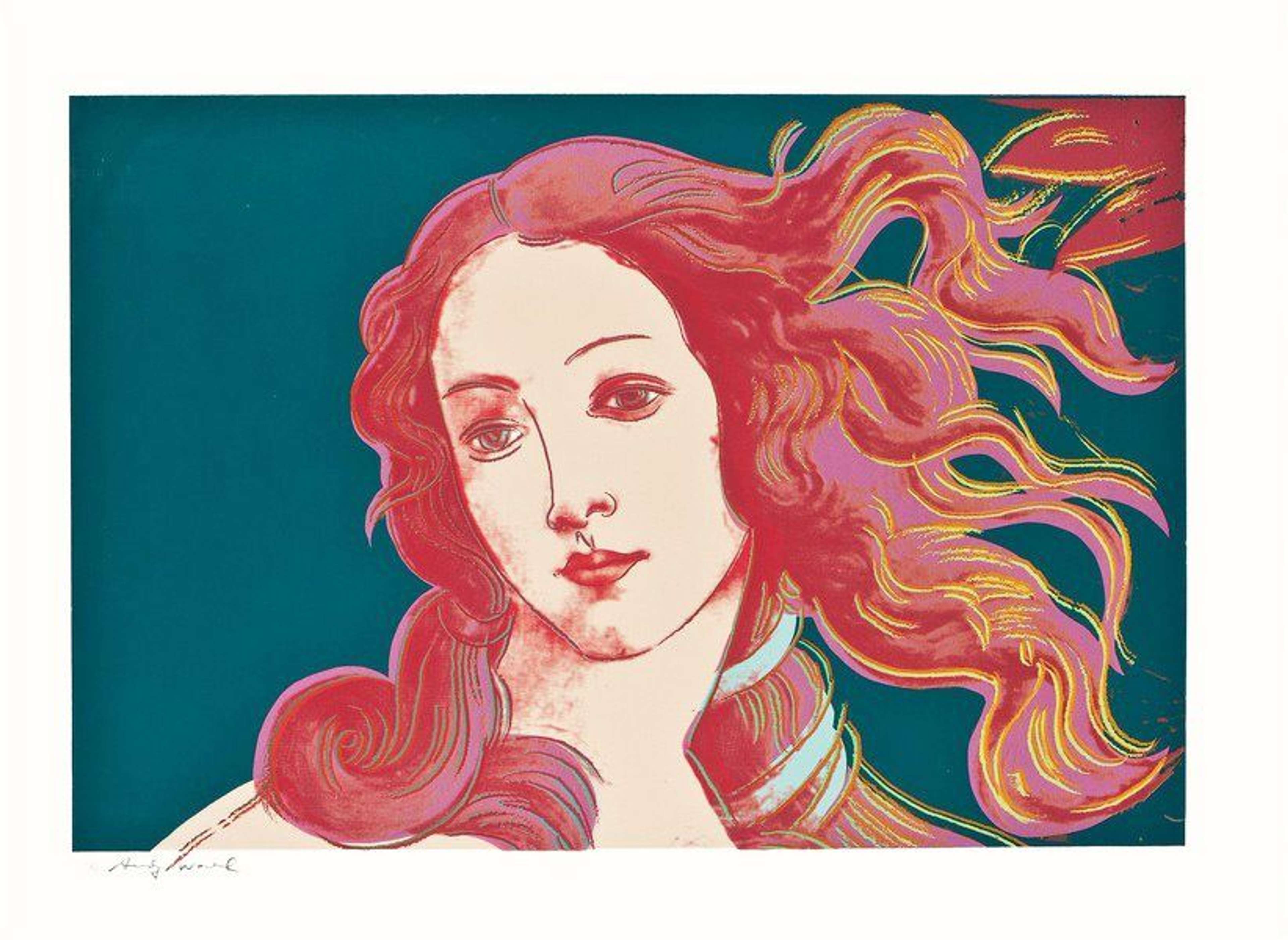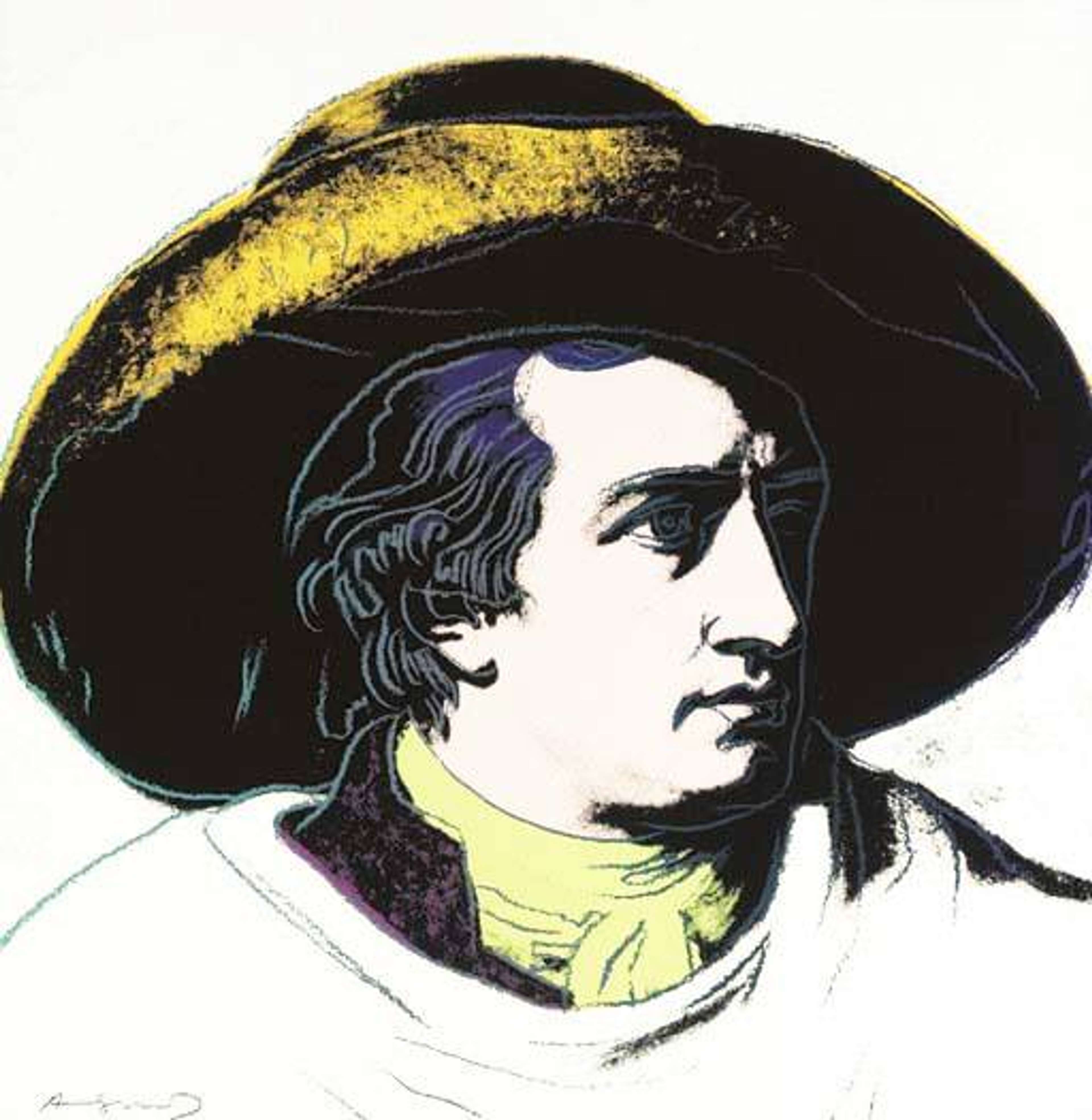 Goethe (F. & S. II.273) © Andy Warhol 1982
Goethe (F. & S. II.273) © Andy Warhol 1982
Interested in buying or selling
Andy Warhol?

Andy Warhol
487 works
Created in 1982, Andy Warhol's Goethe series imagines the 18th century polymath as a Warholian icon. Each coloured screen print in the series comes in a limited edition size of 100, and offers a Pop Art spin on classical portraiture.
The series depicts Wolfgang von Goethe.
 Goethe (F. & S. II.271) © Andy Warhol 1982
Goethe (F. & S. II.271) © Andy Warhol 1982In this unusual hark back to the past, Warhol depicted Wolfgang von Goethe across four screen prints. Hailing from Germany, Goethe was an 18th century polymath and was respected across the fields of literature, poetry, theatre, science, and aesthetic criticism. The series reveals Warhol's respect for the past, even though his Pop Art was grounded in current culture, and perhaps his aspirations to become a modern day Goethe himself.
The series is based on a famous painting by Johann Tischbein.
 Image © Creative Commons / Goethe In The Roman Campagna © Johann Tischbein 1787
Image © Creative Commons / Goethe In The Roman Campagna © Johann Tischbein 1787Like most of Warhol's celebrity portraits, the image of Goethe in this series was appropriated from an existing portrait of the polymath by Johann Tischbein. In the original portrait, we see Goethe reclining before a scene of ruins, romantically alluding to his role in the long history of the arts. In Warhol's Pop reinvention of Tischbein's portrait, the image is cropped to focus on the head and shoulders of Goethe alone, almost like a sculpted bust.
Goethe is regarded as the most important German literary figure of modern times.
 Goethe (F. & S. II.273) © Andy Warhol 1982
Goethe (F. & S. II.273) © Andy Warhol 1982Today, Goethe is regarded as one of the most influential writers in the German language, and has been likened to Dante and Shakespeare. By the young age of 25, Goethe was already an acclaimed author and published international bestsellers in his own lifetime, including Faust and Sturm und Drang. Beyond his literary talents, Goethe also flexed his interests in biology with The Metamorphosis of Plant, and colour perception in his Theory of Colours.
Warhol was fascinated with art history.
 Details Of Renaissance Paintings (Sandro Botticelli, Birth Of Venus, 1482) (F. & S. II.316) © Andy Warhol 1984
Details Of Renaissance Paintings (Sandro Botticelli, Birth Of Venus, 1482) (F. & S. II.316) © Andy Warhol 1984Particularly towards the end of his life and career, Warhol increasingly turned to the icons of art history, rather than the icons of his age. Alongside the Goethe series, we also see his fascination with art history in his Renaissance Paintings series which was created two years later in 1984.
Warhol himself was quite the modern polymath.
 The Shadow (F. & S. II.267) © Andy Warhol 1981
The Shadow (F. & S. II.267) © Andy Warhol 1981Throughout his career, Warhol demonstrated his talents as a commercial illustrator, painter, printmaker, photographer, and filmmaker. In his homage to Goethe in this series, Warhol revealed his respect for a fellow polymath, and potentially signalled how he was following in his footsteps.
The series alludes to Goethe's Theory of Colours.
 Goethe (F. & S. II.270) © Andy Warhol 1982
Goethe (F. & S. II.270) © Andy Warhol 1982In his 1810 Theory of Colours, Goethe conceptualised a symmetrical colour wheel and his own views of the perception of colour by humans. In this series, Warhol injected Goethe's portrait with distinctively Pop colour. The series is perhaps an homage to Goethe's interpretation of colour, and Warhol expressed him as an essential figure in the history of art.
The series represents Goethe as a Warholian icon.
 Marilyn (F. & S. II.25) © Andy Warhol 1967
Marilyn (F. & S. II.25) © Andy Warhol 1967By reducing Tischbein's original portrait to Goethe's head and shoulders, the German polymath was represented as a modern Warholian icon. Like his depictions of Marilyn Monroe and Liz Taylor, Warhol depicted Goethe in vivid and unnatural colour. As an icon of Warhol's creation, Goethe is represented as almost super-human because of his unique role in culture.
The series is typical of Warhol's later approach to the celebrity.
 Beethoven (F. & S. II.392) © Andy Warhol 1987
Beethoven (F. & S. II.392) © Andy Warhol 1987Throughout the 1960s and 70s, Warhol had his finger on the pulse of pop culture. By representing the stars, events, and products of his age, he created a genre of art which mirrored the beautiful mediocrity of the every day. However, in the 1980s Warhol turned to celebrities of the past. Though there are many interpretations of Warhol's later shift in subject matter, many believe this to be an attempt to insert himself in a lineage of ’great’ thinkers and creators.
Warhol draws particular attention to Goethe's gaze.
 Goethe (F. & S. II.272) © Andy Warhol 1982
Goethe (F. & S. II.272) © Andy Warhol 1982By cropped the Tischbein's original painting, Warhol drew greater attention to Goethe's searching gaze. Though we cannot see what Goethe directs his gaze to in Warhol's portraits, the harsh contrast in light emphasises the intensity of the thinker's stare.
The series is testament to the enduring image of the celebrity.
 Mick Jagger (F. & S. II.142) © Andy Warhol 1975
Mick Jagger (F. & S. II.142) © Andy Warhol 1975From the 1960s until his death in 1987, Warhol immortalised the icons of his age in print. Beginning with images from mass-media, or Polaroid photographs the artist snapped himself, Warhol created vibrant portraits that spoke to the character of his celebrity sitters. Though Goethe might seem like a strange choice of celebrity, Warhol's turn to the past is a testament to his fascination with stardom nonetheless.
